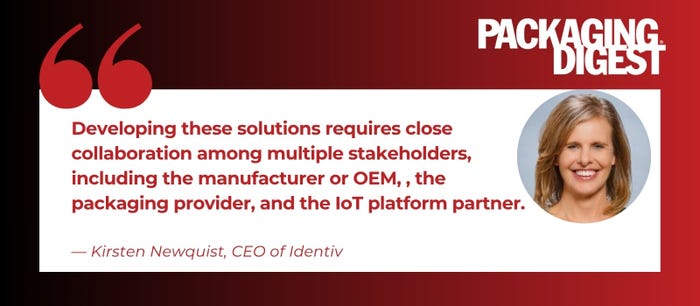The safety and security of pharmaceutical drugs are bolstered by patient smart packaging, whereby digital intelligence is integrated directly into the packaging to provide a unique digital identity for the item that can easily be tracked.
One company heavily entrenched in the space is Identiv, a Santa Ana, CA-based company founded in Munich, Germany, in 1990. The enterprise provides digital identities for physical objects to facilitate asset tracking, supply chain management, regulatory compliance, and consumer engagement.
We asked Kirsten Newquist, CEO of Identiv, to share her insights on patient smart packaging.
Why is there a market for smart packaging?
Newquist: Among the trends driving demand for smart packaging in healthcare are increasing concerns over patient safety, due to counterfeit drugs; regulatory mandates, such as the United States Drug Supply Chain Security Act (DSCSA) requiring unit-level serialization; and the need for real-time cold chain monitoring for high-value, temperature-sensitive biologic medicines.
Pharmaceutical companies also need to have enhanced visibility and operational efficiency, plus the desire for increasing patient intimacy through access, support, and communication between patients and healthcare providers in response to expanded care touchpoints beyond traditional channels.
These market growth drivers are expected to persist, irrespective of broader economic conditions or trade policies.

How is smart packaging implemented?
Newquist: Smart packaging is typically implemented by attaching or embedding a radio frequency identification (RFID) or a Bluetooth Low Energy (BLE) inlay into the product’s packaging or the labeling.
These inlays are designed to withstand the product’s physical environment, including refrigeration, handling, or sterilization, and can include sensors to provide additional intelligence; for example, sensors that can monitor ambient conditions such as temperature or humidity.
Developing these solutions requires close collaboration among multiple stakeholders, including the manufacturer or original equipment manufacturer (OEM), the packaging provider, and the Internet of Things (IoT) platform partner.
What are the benefits of smart packaging?
Newquist: Smart packaging offers significant operational and safety benefits. It helps pharmaceutical companies comply with regulations like DSCSA by enabling unit-level serialization and traceability while improving supply chain visibility with real-time data on product location and condition.
For temperature-sensitive drugs like biologics or vaccines, packaging with embedded sensors can maintain cold chain integrity and prevent spoilage.
From the provider perspective, smart packaging offers confidence in drug authenticity and safety, while from a patient perspective, smart packaging also opens new opportunities for digital engagement, such as accessing authentication or usage information.
How can the cost of smart packaging justify the expense?
Newquist: While smart packaging requires a sizable initial investment, its return on investment (ROI) is realized across multiple critical areas. It substantially reduces the risk of counterfeiting and spoilage, which is critical for high-value, temperature-sensitive medications.
Smart packaging also enables enhanced inventory management and real-time supply chain optimization. Furthermore, it streamlines complex and costly regulatory compliance through automated data capture and reporting via RFID-based serialization.
Beyond operational efficiencies, smart packaging cultivates invaluable patient engagement and trust. When considering this comprehensive lifecycle value, smart packaging more than justifies its investment.
What are the most promising features of smart packaging?
Newquist: Future innovation within this space lies in connectivity to deliver new experiences for practitioners. Identiv’s collaboration with Novanta, for instance, enables smart packaging to interact seamlessly with smart medical devices and hospital systems.
Features such as medication adherence monitoring and automated asset tracking are turning packaging into a data-rich interface for connected care. These next-generation characteristics are helping transform packaging from a regulatory checkbox into a critical component of patient safety, hospital efficiency, and personalized medicine.
How do you foresee patient smart packaging evolving further?
Newquist: We at Identiv believe patient smart packaging will evolve beyond simple connectivity to delivering true operational intelligence. As application-specific IoT becomes more prevalent, smart packaging will evolve beyond tracking usage and adherence to delivering contextual data that drives real-time insights, supports clinical decision-making, and improves patient outcomes.
These purpose-built solutions will enable packaging to respond to its environment, optimize performance over time, and play a more active role in personalized healthcare.